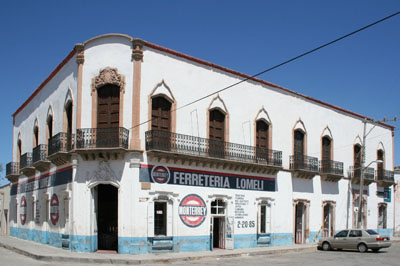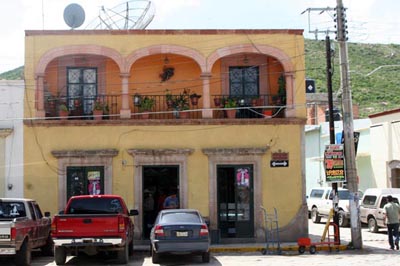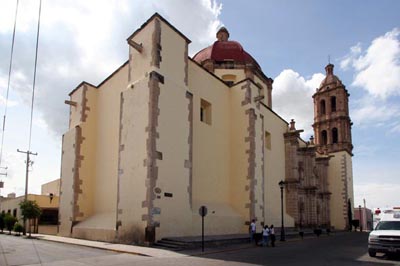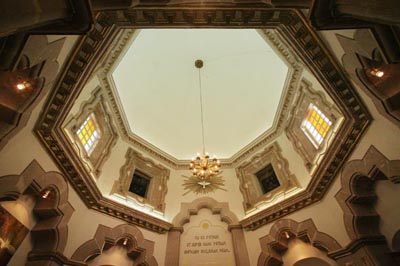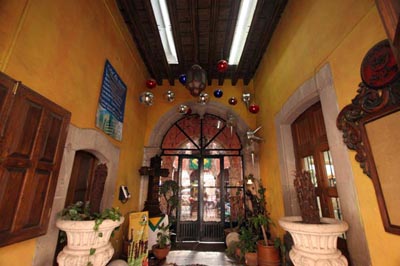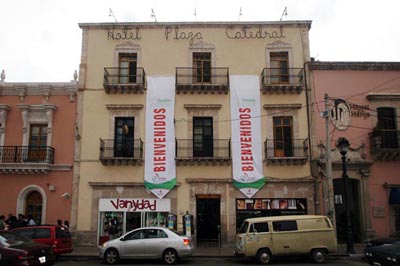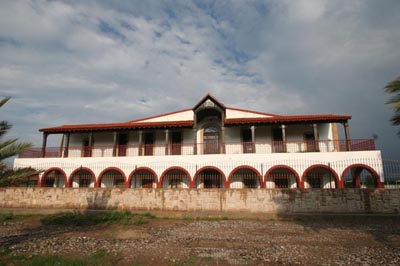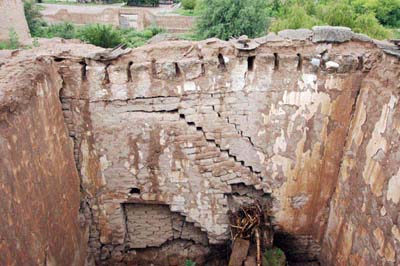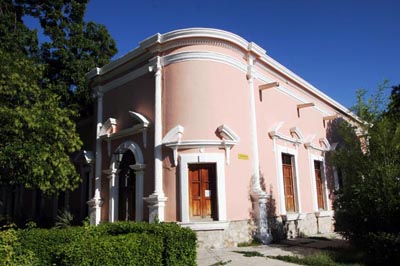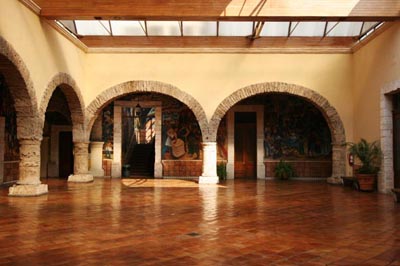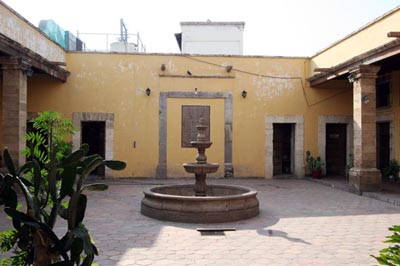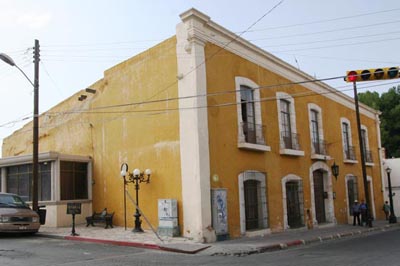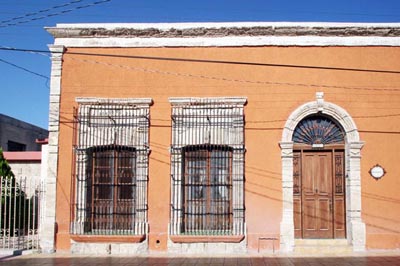Adobe Architecture In Mexico
For almost three thousand years, Mesoamerica was the site of several advanced Amerindian civilizations such as the Olmec, the Maya and the Aztecs. Already from that time people were building their houses with adobes and wattle and daub. Even the religious and monumental architecture was using adobes and earth material: the pyramids of Teotihuacan were built by the Maya with adobe / compacted earth and covered with volcanic stones. Nearly nothing remains from the rural and urban earthen architecture that were built long ago by these civilizations, expect at Paquimé in the northern state of Chihuahua.
In 1519, the native civilizations of what now is known as Mexico were invaded by Spain. This was one of the most important conquest campaigns in America. The Spanish conquistadors adopted the traditional way of building, the adobes, to build a typical colonial architecture: rural, urban and religious. The Spaniards, in their search for silver and gold, developed many settlements along a road going from Mexico City to Santa Fe in what is today USA. These roads were named Camino Real or “Silver route” and most of the settlements created along this route were built with adobes.
"El Camino Real" Or The Silver Route
Most of the information presented hereafter on El Camino Real was kindly communicated by the Architect Alberto Ramírez Ramírez, director of Conaculta-INAH Durango (Instituto Nacional de Antropologia y Historica). Ar. Alberto Ramírez was also very helpful for the guided visit of Durango city.
Long before Europeans arrived, indigenous people of the Americas established a trade network along portions of what would become El Camino Real. Salt, hides, minerals for making paint and turquoise were transported south by foot. Built on the old-Mesoamerican paths that permitted trade and military raids by the Aztec empire into the territories towards the north, and in the south through the “Turquoise Route”, the “Camino Real” has left us a valuable cultural heritage that includes missions, cathedrals, civil buildings, garrisons, mining and farming haciendas, as well as numerous everyday objects and religious works of art and all kinds of archives.
Attacks by Comanche, Apaches and Cherokees on villages, haciendas and ranches led to an intermittent war that did not end until the area was fully pacified in the mid-nineteenth century. Settlements in the north of Mexico would not have been impossible without the Camino Real. Indeed, the social formation, historical meaning and shared cultural identity present in these territories today are the result of the vitality of the routes opened up in 1598 by the explorations of Juan de Onate, nicknamed as “The Pioneer”.
Caminos real or royal roads were the main transportation routes for communication, cultural exchanges, trade, and commerce. Travellers, livestock, and cargo were protected by the Spanish military, dispatched in “compañías volantes”, literally, flying companies of light cavalry. Four main caminos reales radiated form Mexico City. They formed a busy transportation network bustling with foot traffic, wagons, and mule trains. Cargo was transported to and from the seaports of Veracruz and Acapulco to Mexico City.
The southern route stretched south to Guatemala. By 1598, the Camino Real extended northward from Mexico City through Zacatecas all the way to Santa Fe and beyond – a distance of over 1500 miles! Other caminos reals connected eighteenth century settlements in Texas and in California. After more than four centuries. El Camino Real de Tierra Adentro, the royal road to the interiors, is one of the oldest continuously used roads in North America.
Very beautiful examples of adobe buildings can be seen on the various settlements developed along El Camino Real de Tierra Adentro.
Zacatecas, the rise of mining
During the 16th century, several expeditions set off from Nueva Galicia (now known as Jalisco) to the northeast in search of new lands and riches. The Basque captain Juan de Tolosa led a small expedition comprising Spanish soldiers, Franciscan friars and indigenous people in search of silver mines. The first mining haciendas began to be built in late 1547. This marked the start of a spectacular silver and demographic boom in the region, one of the most densely populated areas in New Spain after Mexico City and Puebla for much of the 16th century in 1550. The definitive Camino Real or Royal Silver Route was built to link the capital of New Spain to Zacatecas, thereby creating one of the most important trading and cultural routes in the Vice-royalty.
It was Juan de Oñate who, in 1598, would extend El Camino Real to New Mexico. Zacatecas played a key role in the evangelization, dissemination of Spanish culture and adobe construction in the north of Mexico and the south of the United States. Franciscans, Augustinians and Dominicans arrived in the city in the late 16th early 17th century.
The route, built along a south-north axis, passed through villages such as Ojuelos, Matancillas, Encinillas, San Jose de Letras, Los Campos, La Montesa, Ciénaga Grande, Tepezalá and Asientos. It is still possible to see some of the fortifications built during the long period of war against the Chichimeca. Outstanding mining villages include Asiento, which reached its florescence during the 18′” century. Some signs still remain of its former wealth, including ancient vice regal mansions with stone facades, spacious patios and old arches, or churches such as Nuestra Senora de Belen, built between 1705 and 1715 and the Sanctuary of the Virgin of Guadalupe, completed in 1765.
Chihuahua is the largest state in Mexico. It is the site of Paquimé, one of the oldest settlements in the country which was entirely built with adobes, with its distinctive “sunken dwelling”. The Spaniards were challenged by frequent rebellions by the original inhabitants (Conchos, Sumas; Janos and Julimes, among others). This unrest led to the construction of the military forts known as garrisons in places such as Janos, San Buenaventura, San Carlos, San Francisco de Conchos and Jimenez. Unfortunately, no significant vestiges of these buildings remain.
The first explorers of this region were Cristóbal de Oñate, José Angulo and Ginés Vázquez de Mercado. In 1554, Captain Francisco de Ibarra named it in the Valle de Guadiana. The city of Durango was founded on the 8th July 1563 by this same expedition leader as the capital of the province of Nueva Vizcaya. It played an important historical role in Spanish expansion towards the north, setting out from there to colonize Chihuahua, Sonora and New Mexico.
Among the villages connected by the Camino real are Cuencamé, built as a major missionary centre, Nazas founded as a Jesuit mission in 1725; San Pedro del Gallo, a resting place and watering hole before it was turned into a garrison; Mapimí, destroyed three time due to attacks by the Cocoyom and Toboso tribes; Villa Hidalgo. The northern-most settlement in the region and the site of the first garrison in Durango; Juana Guerra, a hacienda whose chapel is one of the finest expressions of the baroque in the state and Navacoyán, housing one of the most important remains on this route: the Puente del Diablo, built in 1782.
Aguascalientes
The route, built along a south-north axis, passed through villages such as Ojuelos, Matancillas, Encinillas, San Jose de Letras, Los Campos, La Montesa, Ciénaga Grande, Tepezalá and Asientos. It is still possible to see some of the fortifications built during the long period of war against the Chichimeca. Outstanding mining villages include Asiento, which reached its florescence during the 18′” century. Some signs still remain of its former wealth, including ancient vice regal mansions with stone facades, spacious patios and old arches, or churches such as Nuestra Senora de Belen, built between 1705 and 1715 and the Sanctuary of the Virgin of Guadalupe, completed in 1765.
Chihuahua
Chihuahua is the largest state in Mexico. It is the site of Paquimé, one of the oldest settlements in the country which was entirely built with adobes, with its distinctive “sunken dwelling”. The Spaniards were challenged by frequent rebellions by the original inhabitants (Conchos, Sumas; Janos and Julimes, among others). This unrest led to the construction of the military forts known as garrisons in places such as Janos, San Buenaventura, San Carlos, San Francisco de Conchos and Jimenez. Unfortunately, no significant vestiges of these buildings remain.
Durango, expansion towards the north
The first explorers of this region were Cristóbal de Oñate, José Angulo and Ginés Vázquez de Mercado. In 1554, Captain Francisco de Ibarra named it in the Valle de Guadiana. The city of Durango was founded on the 8th July 1563 by this same expedition leader as the capital of the province of Nueva Vizcaya. It played an important historical role in Spanish expansion towards the north, setting out from there to colonize Chihuahua, Sonora and New Mexico.
Among the villages connected by the Camino real are Cuencamé, built as a major missionary centre, Nazas founded as a Jesuit mission in 1725; San Pedro del Gallo, a resting place and watering hole before it was turned into a garrison; Mapimí, destroyed three time due to attacks by the Cocoyom and Toboso tribes; Villa Hidalgo. The northern-most settlement in the region and the site of the first garrison in Durango; Juana Guerra, a hacienda whose chapel is one of the finest expressions of the baroque in the state and Navacoyán, housing one of the most important remains on this route: the Puente del Diablo, built in 1782.
Templo Santa Ana, Durango City
Templo Santa Ana is in fact a church, as often a church is named Templo or Iglesia in Spanish. Templo Santa Ana was built in Durango City, Durango State in 1760. Like all the urban, suburban and major buildings in rural areas, which are showed hereafter in this page, this church is plastered with lime plaster. While adobes are the main building material for the walls, the entrance of the church as well as the columns, arches and rib arches are built with stones. The vault is built with fired bricks. This shows mastery in the combination of materials and techniques. These features are seen in all major buildings which are using adobes as the main building material for the walls. Simple buildings in rural areas are also most of the time built with adobes but they are not necessarily plastered.
Caja Real, Durango City
Caja Real were registration offices of funds and properties and the Caja Real at Durango was also stamping the silver and gold coins. This Caja Real was built in the late 17th century and it is today a restaurant.
Cultural centre and office of INAH, Durango City
This building was built in the 19th century as a hospital. It withstood the revolution which started in 1910, as witness it the traces of bullets on the stone façade. Like the other major buildings showed in this page, adobes are the main building material for the walls and the openings have window posts, door posts and arches done with stones. It is today a Cultural centre and it welcomes also the office of Conaculta-INAH
Various houses, Durango City
The count of Súchil built in 1776 the house, known in Spanish as Casa Conde del Valle de Súchil. During the 19th century the house was used for commercial purposes, and was then known as “Casa Cadena”. In 1988 the old mansion was refurbished and it welcomes today a bank.
Hacienda Pedriceña, Durango State
The hacienda Pedricena was built in 1820 in the village Los Ladrillos. It was part of the development founded by Carlos Michaud in the area of Los Ladrillos. The hacienda has been entirely restored as showed hereafter.
Hacienda La Goma at La Goma, Durango State
The hacienda La Goma and Church were built in the 17th century at La Goma village. The church is always in service, but the hacienda has not been used for a long time. Therefore some parts are deteriorated and most of the roofs are leaking. Funds are being looked after for restoring the hacienda and the work should be started soon, under the supervision of INAH Durango. The restoration project is to transform the hacienda into a school for the village.
Hacienda Santa Santissima Trinidad at La Loma, Durango State
The hacienda Santa Santissima Trinidad was built in 1820 at La Loma village. The hacienda welcomes a small museum with an exposition on traditional heritage and on the revolution of 1910. But some parts of the hacienda are quite deteriorated and many parts of the roof are leaking. Funds are being looked after for restoring the hacienda and INAH Durango should supervise the restoration the work once it will be started.
Church of Santa Ana de Hornos ~17th century, Coahuila State
This church was built in the village Santa Ana de Hornos. Villagers said that it was built around 1600. The exact date of construction is not known but it seems that this date is not far from the truth as the historical development of the settlements in this area are also recorded from 1600 onwards.
Church and college Ignacio de Loyola at Parras, Coahuila State
Parras was officially funded in 1598 by Captain Antón Martín de Zapata who acted as the Justice Mayor of Parras at that time. The church and college were built with adobes in 1607. The church has a very simple wooden ceiling and an altar covered with gold dust. The college has paintings from the 17th century as well as valuable archives.
Chapel Santo Madero at Parras, 1868
This chapel was built from 1868 to 1880 on top of the mount Sombreretillo. Built with adobes and plastered with lime plaster, it shows very simple lines and is very sober, unlike many other churches and chapels.
Cultural house at Parras
This cultural house was built with adobes as a house around the 18th century. It displays now a few belongings of Francisco I. Madero, mostly paintings, and other very valuable objects of the community of Parras.
Church San Esteban at Saltillo, Coahuila State
This church was built in 1592. In 1847 it was used as a hospital during the Battle of Angostura. This church built with adobes and plastered with lime plaster is very sober, compared to the heavy baroque style used in the area for the other churches and chapels.
Coahuila Cultural Institute at Saltillo
It was built as a mansion in the 18th century and it was recently remodelled to welcome the Coahuila Cultural Institute. It now houses a cafe, a library, and exhibition halls where temporary exhibits of paintings, sculptures, drawings and other art forms are held. It is adjacent to the pottery school (see hereafter) which was built at the same time, also as a mansion with the same type of architecture.
Pottery School at Saltillo
It was built as a mansion in the 18th century. It welcomes today a pottery school which is adjacent to the Coahuila Cultural Institute. It has the same type of architecture as the Cultural Institute and it was built as at the time.
Cultural Centre Vito Alessio Robles at Saltillo
This centre was built in the 18th century and it preserves today a large and valuable book collection, as well as personal objects of this renowned historian, Vito Alessio Robles. The murals in the central patio stand out as well as the filmed works of Elena Huerta. In addition, there are temporary exhibits featuring sculptures paintings and photography.
Recinto de Juárez at Saltillo
After the French army conquered Mexico City in June 1863, the president Juárez was dismissed and the Archduke Maximilian of Austria-Hungary, a Hapsburg, proclaimed second Emperor of Mexico. In December 1863 the president Juárez and his family stayed for a few months in this house at Saltillo and it is known today as Recinto de Juárez. This house was probably built in the 19th century.
Cuatro Ciénegas, Coahuila State
The name of the city Cuatro Ciénegas is Spanish for “four marshes”: The name was chosen by the first settlers because of the natural springs in the vicinity that create extensive areas of wetland and lakes. Several failed settlements were founded here prior to the successful establishment of a town by Antonio Cordero y Bustamante on 24 May 1800. The settlement’s original name was Nuestra Señora de los Dolores y Cuatro Ciénegas, which was later changed to Villa Venustiano Carranza, before finally settling on its current name. Most of the buildings showed hereafter date therefore from 1800 onwards.
Contact US
- Address:Auroville Earth Institute, Auroshilpam, Auroville 605 101 - T.N. India
- Phone:+91 (0) 413 - 262 3330 / 262 3064
- Email:info@earth-auroville.comOpens in your application






